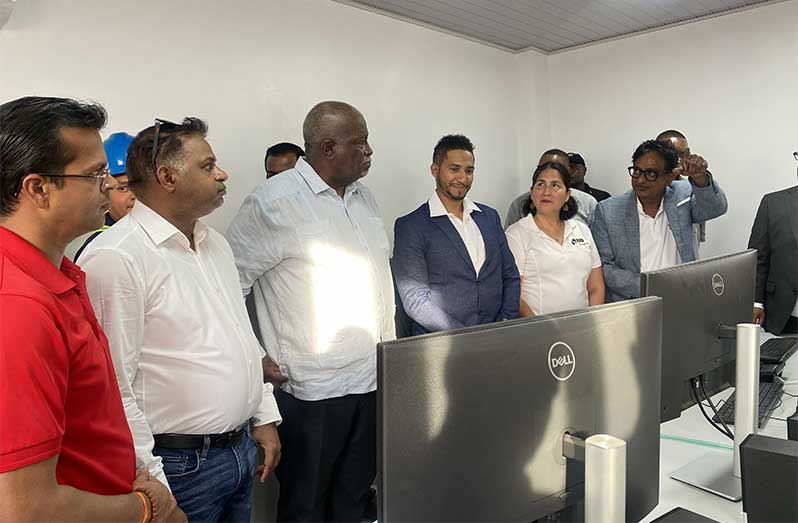Copyright guyanachronicle

THOUSANDS of residents across Region Two (Pomeroon-Supenaam) can now look forward to more reliable, clean, and renewable energy following the commissioning of the 5MWp solar farm at Onderneeming. The project is expected to significantly reduce power outages and contribute to Guyana’s transition toward sustainable energy. Speaking at the commissioning ceremony held at the Onderneeming Solar Farm Phase 2 site, Prime Minister Brigadier (Ret’d) Mark Phillips described the initiative as a milestone achievement in the government’s commitment to energy security and sustainability. “This project represents another step forward in our national efforts to deliver clean and affordable energy to the people of Guyana,” Prime Minister Phillips said. He praised the contractors for their dedication, noting that the site was transformed from dense forest into a modern solar facility within the project timeline. The Prime Minister emphasised that the government remains focused on providing cleaner, renewable energy alternatives. He recalled that Guyana had secured US$270 million to fund renewable energy projects, a portion of which was used to procure solar panels. Upon returning to office, the PPP/C administration decided to utilise the funds to develop 33MW of solar energy across four administrative regions, with the largest installation in Region Ten. “You have moved from 16 megawatts to 22.5 megawatts to meet the region’s demand. This allows us to rest the generators during the day while using solar energy,” Prime Minister Phillips explained. He assured residents that the cost of electricity would not increase as a result of the project and highlighted that savings from reduced fossil fuel use would benefit consumers. The Prime Minister also spoke about the broader national energy plan, which includes constructing several solar farms in hinterland regions, distributing 37,000 solar panels to riverain communities, and developing mini-hydropower facilities. Between 2025 and 2031, the government aims to advance a 125MW hydropower project as part of its long-term clean energy strategy. “With energy and food security at the forefront, Guyana is moving closer to climate security. Our President continues to champion this cause on the global stage,” Phillips said, encouraging the business community to utilise the now reliable energy supply to drive economic growth. Executive Manager of the Guyana Power and Light (GPL), Kesh Nandlall, described the project as transformative and a “proud moment for the people of Essequibo.” He noted that the plant, built under the GUYSOL Programme, will operate during the day and contribute to the 33MW of solar power being developed nationwide. “Essequibo’s demand is around 8 megawatts by day and 8.5 megawatts by night. With this new addition, the region will now benefit from 22 megawatts of generating capacity,” Nandlall explained, noting that the solar farm cost US$10.4 million. Nandlall said the site is not just another solar array — it stands as Guyana’s largest hybrid solar-plus-storage power station, featuring a cutting-edge 7.5 MWh Battery Energy Storage System (BESS). By pairing 5 MW of solar generation with advanced battery storage, the facility can capture excess daytime energy and release it after sunset, helping to stabilize the local grid and provide a reliable, clean power supply even when the sun isn’t shining. For the Essequibo Coast’s isolated grid, he said it represents a transformative technical milestone. The installation spans 13 acres of land that underwent significant development works, with a total investment of US$10.4 million (GY$2.2 billion). Currently, Essequibo’s installed diesel generation capacity is approximately 16 MW (with around 13 MW available due to ongoing maintenance), meeting a peak demand of about 8.5 MW. The newly commissioned Onderneeming Solar Farm now adds roughly 4 MW of clean generation to the system, while a sister solar plant at Charity—soon to be completed—will contribute an additional 2.3 MW. “In the near future, the Essequibo Coast will boast approximately 22.3 MW of total generation capacity, nearly three times the region’s current peak demand. This increase provides a significant reliability buffer, enabling maintenance of generators without disrupting supply,” Nandalall said. Meanwhile, IDB Country Representative for Guyana, Lorena Solorzano, lauded the project as a symbol of strong partnerships and environmental progress. She highlighted the collaboration between Guyana and Norway under the GUYSOL initiative, which has enabled the country to access climate funds to expand renewable energy. “Guyana is on track to achieve 19 percent renewable energy integration,” Solorzano stated. “This project benefits over 12,000 residents, providing more stable electricity for homes, schools, and health facilities.” She also emphasised the importance of women’s participation in the energy sector, noting that more than 15 people, including women, received specialised training in solar panel maintenance. “The impact of this project goes beyond energy; it enhances livelihoods and creates opportunities,” she said. The Onderneeming Solar Farm was executed through a joint venture between SUMEC Complete Equipment and Engineering Company Limited and XJ Group Corporation. Financing was provided through the US$83.3 million Guyana–Norway partnership, administered by the Inter-American Development Bank (IDB)



